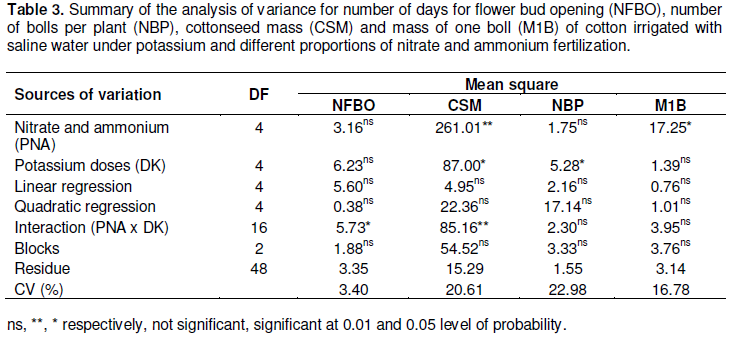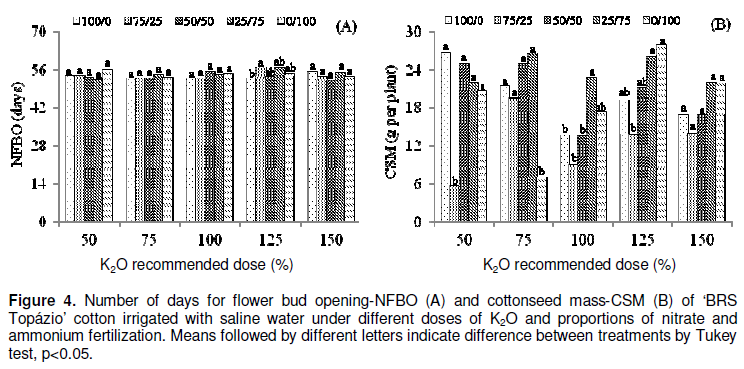ABSTRACT
This study aimed to evaluate growth and production components of the colored cotton cultivar ‘BRS Topázio’ irrigated with saline water as a function of dose of potassium and proportions of nitrate and ammonium. The study was conducted in drainage lysimeters under greenhouse conditions, in a eutrophic Gray Argisol of sandy clay loam texture, in the municipality of Campina Grande, Brazil, from November 2014 to March 2015. A randomized block design was used to test five doses of potassium-DK (50, 75, 100, 125 and 150% of the recommendation for pot experiments) and five proportions of nitrate and ammonium-PNA (100/0, 75/25, 50/50, 25/75 and 0/100 mg of N kg-1 of soil). The K dose referring to 100% corresponded to 150 mg of K2O kg-1 of soil. N supply in NO3-/NH4+ proportion of 25/75, promoted increase in growth variables (plant height, stem diameter and leaf area) and mass of cotton bolls. The K dose of 145.5 mg of K2O kg-1 of soil promoted the formation of higher number of bolls plant-1. The application of K in the doses of 112.5 and 187.5 mg of K2O combined with 25/75 and 0/100 mg of NO3-/NH4+ promoted increment in cottonseed mass and the dose of 187.5 mg of K2O associated with 25/75 mg of NO3-/NH4+ increased the number of days for flower bud opening.
Key words: Gossypium hirsutum L., saline stress, mineral nutrition
Belonging to the Malvaceae family, cotton (Gossypium hirsutum L.) is an oil seed crop cultivated in many regions of Brazil and worldwide, due to the versatility of its production. It is the main raw material for the textile industry, because of the characteristics and utilities of its fiber, and it is also used for the production of oil and other byproducts (Viana, 2014), constituting an important option for the economy, both for enabling labor force to remain in rural areas and creating jobs.
Cotton is one of the major agricultural, industrial and commercial commodity in various parts of the world. Cotton contributes significantly to Brazil’s agricultural output and foreign exchange earnings. In terms of global production, China, USA, India, Pakistan and Uzbekistan are the world's major cotton producing countries, accounting for nearly 60% of the world production (FAOSTAT, 2015). In Brazil cotton production in the crop year 2013/14 was estimated at 7.2 million bales from an estimated area of approximately of 1.1 million hectares, representing a 20% increase in comparison to 2012/13 in production as well as planted area (CONAB, 2014).
The scarcity of water resources in the semi-arid region of Northeast Brazil and high salinity of water sources have led to the search of alternatives for the more efficient and the rational use of waters considered as of low quality (Alves et al., 2011). In this region, the use of brackish water can be an option for the production of crops like cotton, considering that this species tolerates high salt concentrations in the root zone (Oliveira et al., 2009, 2012, 2013; Sousa et al., 2010).
The use of water with salt problems can limit plant growth and production, due to the reduction in the osmotic potential of the soil solution, and also cause ionic toxicity, nutritional imbalances or both, due to the excessive accumulation of chloride and sodium (Flowers, 2004). However, plant sensitivity to salinity varies among species, cultivars of the same species and according to some factors like salt type and concentration, exposure time, phenological stage of the crop and availability of nutrients such as N and K, as well as the interaction between both (Ashraf and Harris, 2004).
Nitrogen can be found especially in the forms of nitrate and ammonium in the soil solution; however, relative absorption rates of nitrate and ammonium by higher plants are influenced by factors like the proportion of NO3-/NH4+ in the medium, temperature, carbohydrate concentration in the roots, salt concentration, among others (Taiz and Zeiger, 2009). In addition, the interaction between nitrogen sources (nitric and ammoniacal) has different effects on plant growth and development (Masclaux-Daubresse et al., 2010).
The supply of N as NO
3- can result in decrease of dry matter production in plants with low capacity to reduce nitrate, because, in order to develop its functions in the plants, N needs to be reduced and incorporated into organic compounds (Ali et al., 2007). On the other hand, high levels of ammonium in cell tissues can be toxic and cause negative effects on root and shoot growth
(Hachiya et al., 2012), causing physiological and nutritional disorders (Holzschuh et al., 2009).
Furthermore, the importance of the interaction between nitrogen (NO3-/NH4+) and potassium and the adequate proportion between both in the soil should be considered, because they are limiting factors in the processes of plant growth and development (Xu et al., 2002; Viana and Kiehl, 2010), since higher K absorption allows a rapid NH4+ assimilation, maintaining its content low in the plant and avoiding toxicity. However, in K-deficient plants, there is accumulation of NH4+, with the appearance of lesions corresponding to toxicity by this ion (Ajayi et al., 1970; Dibb and Welch, 1975).
In addition, K plays a key role in osmotic regulation and promotes the maintenance of turgor in guard cells, through the decrease of their osmotic potential, which results in higher water absorption by these cells and, consequently, it leads to greater turgor and stomata opening (LANGER et al., 2004). Thus, this study aimed to evaluate growth and production components of the cultivar ‘BRS Topázio’ of colored cotton irrigated with saline water as a function of potassium and different proportions of nitrate and ammonium fertilization.
The experiment was carried out from November 2014 to March 2015 in pots adapted as drainage lysimeters in a greenhouse, at the Center of Technology and Natural Resources of the Federal University of Campina Grande (CTRN/UFCG), located in the municipality of Campina Grande-PB, Brazil (07°15’18’’ S; 35°52’28’’ W; 550 m).
The experiment was set in a completely randomized block design in a 5 x 5 factorial scheme, with three replicates. The treatments consisted of five proportions of nitrate and ammonium (NO3-/NH4+) (100/0, 75/25, 50/50, 25/75 and 0/100 mg of N kg-1 of soil) and five doses of potassium-DK (50, 75, 100, 125 and 150% of the recommendation for pot experiments, according to Novais et al., 1991). The recommendation of K dose referring to 100% corresponded to 150 mg of K2O kg-1 of soil.
Cotton plants, cv. ‘BRS Topázio’, were irrigated using water with electrical conductivity (ECw) of 6.0 dS m-1, and equivalent proportion of 7:2:1 of Na:Ca:Mg, which is the predominant relation in the waters used for irrigation in the semi-arid region of Northeast Brazil (Medeiros et al., 2003).
Irrigation water was prepared adding NaCl, CaCl2.2H2O and MgCl2.6H2O salts in the water of the local supply system of Campina Grande-PB, considering the relation between ECw and salt concentration (10*mmolc L-1=ECw dS m-1), according to Richards (1954). After preparation and ECw calibration, using a portable conductivity meter, the saline water was stored in 200-L plastic pots, properly protected in order to avoid evaporation.
Drainage lysimeters with capacity for 20 L were used for plant cultivation. Each lysimeter was perforated at the bottom to allow drainage, and a transparent drain with diameter of 4 mm was installed at its base. The tip of the drain inside the lysimeter was involved with a non-woven geo textile (Bidim OP 30), in order to avoid obstruction by soil material. A plastic bottle was placed below each drain for the collection of the drained water to permit estimation of water consumption by plants.
Each lysimeter was filled with a layer of 0.5 kg of crushed stone, followed by 26 kg of soil material from a eutrophic Gray Argisol of sandy clay loam texture, from the district of São José da Mata (Campina Grande, Paraíba). Before filling the lysimeters, the soil was sampled for the determination of chemical and physico-hydric characteristics (Table 1) at the Laboratory of Irrigation and Salinity of the CTRN/UFCG, according to the methodology proposed by Claessen (1997).

The cultivar ‘BRS Topázio’ of colored cotton was used in this study. With light brown fiber, ‘BRS Topázio’ is derived from the crossing between the cultivars Suregrow 31 and Delta Opal. This cultivar stands out for having high fiber percentage (43.5%), high uniformity (85.2%) and high resistance (31.9 gf/tex), which confers excellent characteristics, comparable to white-fiber cultivars and superior to the other colored-fiber cultivars. The mean yield of ‘BRS Topázio’, under irrigated conditions is 2,825 kg ha-1 (EMBRAPA, 2011).
Before sowing, the soil in all the lysimeters was brought to field capacity using respective saline water as per treatment. After seeding, irrigation was performed daily, by applying in each lysimeter the water volume necessary to maintain water content in soil close to field capacity. The volume was applied manually according to plant water demand, which was estimated through water balance: applied volume minus volume drained in the previous irrigation. In order to avoid salt accumulation in the root zone, a leaching fraction of 0.10 was applied every 15 days. Eight seeds of ‘BRS Topázio’ cotton were sown in each lysimeter at a depth of 2 cm and equidistantly distributed. At 15 and 25 days after sowing (DAS), thinning was performed in order to leave only one plant per lysimeter.
Basal dose equivalent to 300 mg of P2O5 kg-1 of soil based on the recommendation of Novais et al. (1991) was applied. Calcium nitrate, ammonium chloride and potassium chloride were used as source of NO3-, NH4+ and K+, respectively. One third of the dose for each nutrient was applied at 15 DAS and the rest in three equal parts, applied together with irrigation water at intervals of 15 days. In order to avoid nitrification of ammoniacal N, together with ammonium chloride a nitrification inhibitor (dicyandiamide) in the dose equivalent to 10% of N was applied.
Cotton growth was evaluated at 30 and 130 DAS through plant height (PH), stem diameter (SD) and leaf area (LA). Production components were measured through the number of days for flower bud opening (NFBO), number of bolls per plant (NBP), cottonseed mass (CSM) and mass of one boll (M1B). Plant height was considered as the distance between plant base and the apical meristem. Stem diameter was measured at 5 cm from the plant base. Leaf area was obtained by measuring the midrib length of all the leaves in the plants, taking into consideration the methodology described by Grimes and Carter (1969), according to Equation 1:
where y is the leaf area and x the midrib length of the main leaf of cotton. Total leaf area was determined by the sum of the leaf area of all the leaves.
The number of days for flower bud opening was determined through daily observations of flower appearance. After harvest (at 150 DAS), the number of bolls per plant was determined. CSM and M1B were measured using an analytical scale with precision of 0.01 g.
The data were subjected to analysis of variance by F test; when significant, regression analysis for potassium doses and test of Tukey for comparison of means at 0.05 probability level for the proportions of NO3-/NH4+were performed using the statistical program SISVAR-ESAL.
According to the summary of the analysis of variance (Table 2), there was a significant effect (p<0.05) of the factor PNA on plant height, stem diameter and leaf area in the evaluated periods. As to DK and the interaction between factors (PNA x DK), there was no significant effect (p>0.05) for any of the analysed variables.
Plant height of ‘BRS Topázio’ cotton varied significantly (p<0.05) as a function of different studied proportions of nitrate/ammonium at 30 and 130 DAS (Figure 1A and 1B). Plants subjected to fertilization with proportions of NO3-/NH4+ of 25/75 mg significantly differed from plants fertilized with 0/100 and 100/0 of NO3-/NH4+. At 130 DAS growth of cotton was lower for the nitrate source, in comparison to the ammoniacal one. The reason why the ion NO3- (100/0 mg) contributed, at least partially, to this lower growth in the plant height, compared to 25/75 mg, can be explained by the high energetic cost for absorption and reduction of nitrate in plant metabolism (Guo et al., 2007), since after its passage through the plasmatic membrane (plasmalemma) of cells from the epidermis and root cortex it is reduced to nitrite (NO2-) in the cytosol and, immediately after, converted to ammonium (NH4+) in the plastid. Ammonium is then incorporated into amino acids by the enzymes glutamine synthetase and glutamate synthetase, forming glutamine, glutamate and other amino acids and their metabolites (Masclaux-Daubresse et al., 2010).
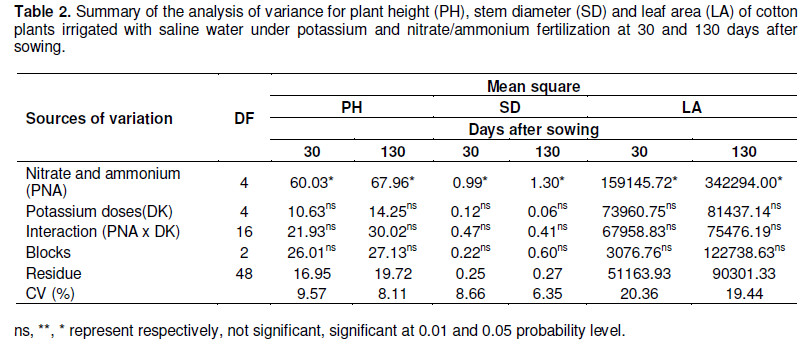
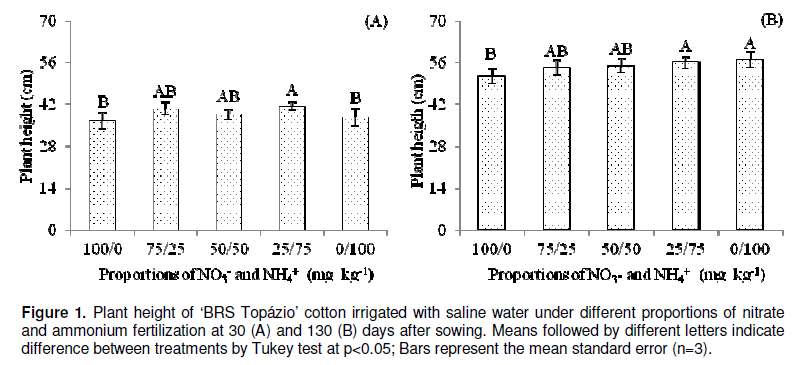
According to the analysis of variance of data of stem diameter of ‘BRS Topázio’ cotton at 30 DAS, there was a significant effect of the studied treatments (Table 2) and according to the means comparison test (Figure 2A), plants fertilized with 75/25 and 25/75 mg of NO3-/NH4+ were superior to plants fertilized with only nitrate (100/0 mg). For plants fertilized with variable proportions of NO3- and NH4+, the highest (6.17 mm) and the lowest (5.53 mm) values of stem diameter were observed for the applications of 25/75 and 100/0 mg of nitrate/ammonium, respectively.
On the other hand, at 130 DAS (Figure 2B), the highest stem diameter (8.80 mm) was obtained for the proportion of 25/75 mg of NO3-/NH4, and there were significant differences in relation to NO3- and NH4+ proportions of 100/0, 75/25 and 50/50 (Figure 2B). The deleterious effect of excessive NO3- on plant growth has been observed in many species, among which cassava (Cruz et al., 2008) and rice (Holzschuh et al., 2009).
The proportions of NO3- and NH4+ significantly influenced the leaf area of ‘BRS Topázio’ cotton at 30 and 130 DAS (Figure 3A and 3B) and, according to the comparison of mean test, plants fertilized with 25/75 mg of NO3- and NH4+ showed the highest values of leaf area, statistically differing from the treatments 0/100 and 100/0 at 30 DAS and 0/100 at 130 DAS. However, comparing the absolute values obtained in the treatment 25/75 at 30 and 130 DAS (1198.08 and 1752.13 cm2, respectively), an increase in leaf area of 242.14, 95.07, 119.48 and 239.84 cm2 at 30 DAS and 423.34, 191.18, 234.69 and 181.98 cm2 at 130 DAS was observed respectively for the treatments 100/0, 75/25, 50/50 and 0/100 of NO3- and NH4+.
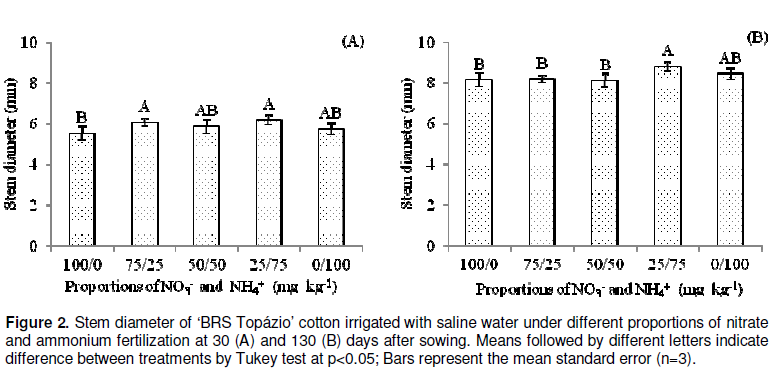
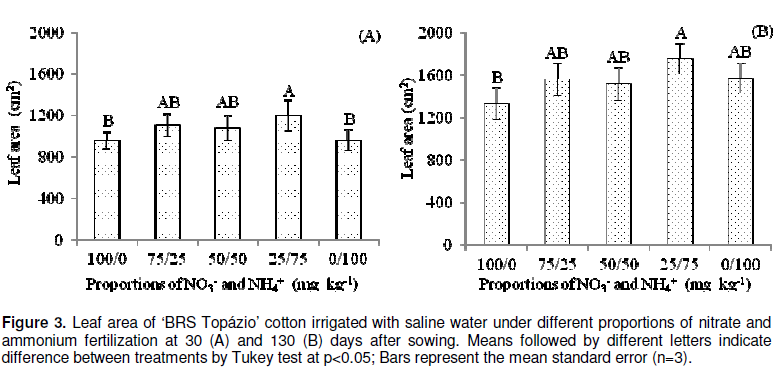
According to Vale et al. (1998), the variation in cations/anions ratio (NO3- and NH4+: 25/75) shows the important role of N in the maintenance of ionic balance in plants. In the predominantly nitrate nutrition, the absorption of anions tends to supersede the absorption of cations, while in the predominantly ammoniacal nutrition, the total absorption of cations exceeds the absorption of anions and, in this case, the electroneutrality is maintained by the efflux of H+ ions. Unlike the results obtained in this study, Cruz et al. (2006) evaluating cassava plants by applying different proportions of nitrate and ammonium (12:0, 9:3, 6:6, 3:9 and 0:12 mol m-3) found that NH4+ is more harmful to leaf expansion as compared to the NO3-.
According to the summary of the analysis of variance (Table 3), there was a significant effect of the different proportions of nitrate and ammonium for cotton seed mass and mass of one boll. As to the factor K doses, there was a significant effect for cotton seed mass and number of bolls. On the other hand, the interaction between factors (PNA x DK) significantly influenced the number of days for flower bud opening and cottonseed mass.
The interaction between K doses and variable proportions of NO3-/NH4+ interfered with the number of days for flower bud opening only when plants were fertilized with 125% of recommended dose of K (Figure 4A), and significant differences occurred in the number of days for flower bud opening, with reductions of 7.60% for the proportion of 100/0 when compared with 75/25 mg of N (NO3-/NH4+).
This increment in NFBO for plants subjected to 25/75 (Figure 4A), in comparison to the other studied treatments, is probably related to the factthat, in both evaluation periods (30 and 130 DAS), the carbohydrates produced by plants were primarily used for the growth of ‘BRS Topázio’ cotton, which is evidenced by the increment in the variables PH, SD and LA. This energy expenditure in the vegetative stage may have contributed to the delay in the number of days for flower bud opening (Helali et al., 2010).
Cotton seed mass was significantly influenced by the interaction between the factors K doses and proportions of NO3-/NH4+ (Table 3) and, according to the mean comparison test (Figure 4B), fertilization with 75/25 mg of NO3-/NH4+ promoted lower production in cottonseed mass (5.64 g plant-1), when plants were subjected to 50% of the recommended dose of K (75 mg of K2O), whereas, the proportions of 25/75 and 0/100 mg of NO3-/NH4+ when combined with doses of 75 and 125% (112.5 and 187.5 mg of K2O), promoted higher cottonseed mass (26.53
and 27.94 g plant-1, respectively).
The number of cotton bolls was significantly influenced (p<0.05) by the different K doses and, according to the regression equation (Figure 5A), the dose of 97% of the recommendation (145.5 mg of K2O) promoted the maximum value for this variable (on average, 6.09 bolls plant-1). In addition, the minimum value for NBP (on average, 4.71 bolls plant-1) was observed in plants fertilized with the dose of 150% (225 mg of K2O). The main hypothesis to explain the observed decrease in the number of cotton bolls in the highest K dose (150%) is based on competitive absorption, in which K is frequently absorbed by many species in amounts greater than the necessary in view of high concentration, inhibiting the absorption of Ca+2 and Mg+2 (Meurer, 2006).
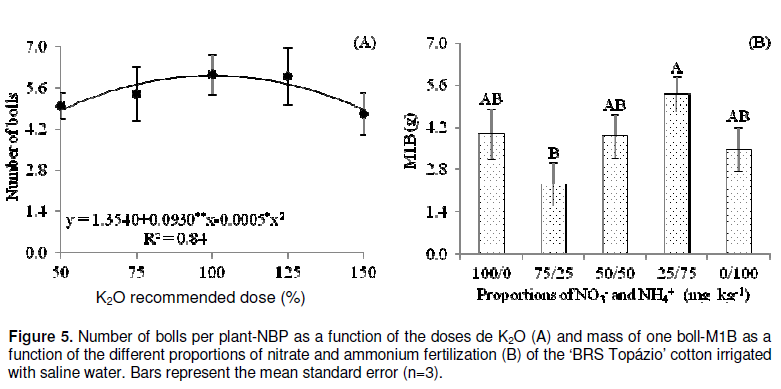
Besides this, the reduction in the number of cotton bolls is a response, for the most part, the osmotic effects, which restrict the absorption of water caused by the high concentration of soluble salts in the soil (especially KCl) as well as the entry of ions in an amount enough to cause toxicity, causing imbalance in the absorption of nutrients, leading to widespread reduction in its growth, with serious losses in crop yields. Similar results were also reported by Andriolo et al. (2010), who evaluated the effects of K doses supplied through fertigation on growth, production and quality of strawberry fruits. These authors concluded that the increase in K concentration in the nutrient solution decreases growth, production and organoleptic quality of fruits. Lima (2014), evaluating the castor bean cultivar ‘BRS Energia’ as a function of salinity and the cationic nature of the irrigation water, observed reduction in the production components of plants subjected to irrigation with water of potassium composition.
The mean mass of one boll (Figure 5B) was significantly different (p<0.05) due to the application of different proportions of NO3-/NH4+. Plants subjected to 25/75 mg of nitrate and ammonium showed higher M1B (5.30 g), significantly differing from plants in the treatment with 75/25. On the other hand, M1B values of plants fertilized with 100/0, 50/50, 25/75 and 0/100 mg of NO3- and NH4+ did not differ statistically. These results reflect the tendency observed for cotton growth variables (PH, SD and LA) evaluated at 30 and 130 DAS, for which the proportion of 25/75 of NO3-/NH4+ promoted higher growth and, consequently, higher production, which is evidenced by the mass of one boll.
1. The supply of NO3- and NH4+ in the proportion of 25/75 mg of N kg-1, respectively, promotes an increase in growth variables (plant height, stem diameter and leaf area) and in the mass of one boll of ‘BRS Topázio’ cotton;
2. The dose of 145.5 mg of K2O (97% of the recommendation) promotes the formation of higher number of bolls per plant;
3. The application of potassium in the doses of 112.5 and
187.5 mg of K2O (75 and 125% of the recommendation) combined with proportions of 25/75 and 0/100 mg of NO3-/NH4+ promotes an increment in cotton seed mass, and the dose of 187.5 mg of K2O (125% of the recommendation) associated with 25/75 mg of NO3- and NH4+ increase the number of days for flower bud opening.
The authors have not declared any conflict of interests.
The authors thank National Council for Scientific and Technological Development (CNPq), the National Institute of Science and Technology in Salinity (INCTSal) and Coordination for the Improvement of Higher (CAPES) for financial support and the grant of fellowship.
REFERENCES
|
Ajayi O, Maynard DN, Barker AV (1970). The effects of potassium on ammonium nutrition of tomato (Lycopersicon esculentum Mill.). Agron. J. 62(6):818-821.
Crossref
|
|
|
|
Ali A, Sivakami S, Raghuram N (2007). Effect of nitrate, nitrite, glutamate, glutamine and 2- oxoglutarate on RNA, levels and enzyme activities of nitrate reductase and nitrite reductase in rice. Physiol. Mol. Plant Pathol. 13(1):17-25.
|
|
|
|
|
Alves MS, Soares TM, Silva LT, Fernandes JP, Oliveira MLA, Paz VPS (2011). Strategies for use of brackish water in NFT hydroponic lettuce production. Rev. Bras. Eng. Agríc. Ambient. 15(5):491-498.
Crossref
|
|
|
|
|
Andriolo JL, Janisch DI, Schmitt OJ, Picio MD,Cardoso FL, Erpen L (2010). Potassium and calcium doses on plant growth, fruit yield and quality of strawberries in soil less cultivation. Ciênc. Rural 40(2):267-272.
|
|
|
|
|
Ashraf M, Harris PJC (2004). Potential biochemical indicators of salinity tolerance in plants. Plant Sci. 166(1):3-16.
Crossref
|
|
|
|
|
Claessen MEC (1997). Manual de métodos de análise de solo. 2. ed. rev. atual. Rio de Janeiro: Embrapa-CNPS, 212 p. (Embrapa-CNPS. Documentos, 1).
|
|
|
|
|
Conab - Companhia Nacional de Abastecimento. Acompanhamento da safra brasileira de grãos (2014). Safra 2013/14. 1(10):1-85. Available in
View
|
|
|
|
|
Cruz JL, Pelacani CR, Araújo WL (2006). Effect of nitrate and ammonium on growth and efficiency of nitrogen use by cassava plants. Bragantia 65(3):467-475.
|
|
|
|
|
Cruz JL, Pelacani CR, Araújo WL (2008). [Influence of nitrate and ammonium on the photosynthesis and nitrogen compounds concentration in cassava]. Ciênc. Rural 38(3):643-649.
Crossref
|
|
|
|
|
Dibb DW, Welch LF (1975). Corn growth as affected by ammonium vs. nitrate absorbed from soil. Agron. J. 68(1):89-94.
Crossref
|
|
|
|
|
Embrapa (2011). Centro Nacional de Pesquisa de Algodão (Campina Grande, PB). Algodão colorido: "Tecnologia Embrapa para a geração de emprego e renda na agricultura familiar do Brasil''. Campina Grande, 2011. 2p. (EMBRAPA-CNPA, Circular Técnico, 17).
|
|
|
|
|
FAO - Food and Agriculture Organization of the United Nations (2015). Statistics, FAOSTAT database results. Available in:
View Accessed on: Oct. 5th 2015.
|
|
|
|
|
Flowers TJ (2004). Improving crop salt tolerance. J. Exp. Bot. 55(396):307-319.
Crossref
|
|
|
|
|
Grimes DW, Carter LM (1969). A linear rule for direct nondestructive leaf área measurements. Agron. J. 3(61):477-479.
Crossref
|
|
|
|
|
Guo S, Zhou Y, Shen Q, Zhang F (2007). Effect of ammonium and nitrate nutrition on some physiological processes in higher plants - growth, photosynthesis, photorespiration, and water relations. Plant Biol. 9(1):21-29.
Crossref
|
|
|
|
|
Hachiya T, Watanabe CK, Fujimoto M, Ishikawa T, Takahara, K, Kawai-Yamada M, Uchimiya H, Uesono Y, Terashima I, NoguchiK (2012). Nitrate addition alleviates ammonium toxicity without lessening ammonium accumulation, organic acid depletion and inorganic cation depletion in Arabidopsis thaliana shoots. Plant Cell Physiol. 53(3):577-591.
Crossref
|
|
|
|
|
Helali SM, Nebli H, Kaddour R, Mahmoudi H, Lachaâl M, Ouerghi Z (2010). Influence of nitrate-ammonium ratio on growth and nutrition of Arabidopsis thaliana. Plant Soil 336(1):65-74.
Crossref
|
|
|
|
|
Holzschuh MJ, Bohnen H, Anghinoni I, Meurer EJ, Carmona FC, Costa SEVGA (2009). Rice growth as affected by combined ammonium and nitrate supply. Rev. Bras. Ciênc. Solo. 33(5):1323-1331.
Crossref
|
|
|
|
|
Langer K, Levchenko V, Fromm J, Geiger D, Steinmeyer R, Lautner S, Ache P, Hedrich R (2004). The poplar K+ channel KPT1 is associated with K+ uptake during stomatal opening and bud development. Plant J. 37(6):828‑838.
Crossref
|
|
|
|
|
Lima GS (2014). Salinidade e natureza catiônica da água de irrigação na morfofisiologia e produção da mamoneira. Tese (Doutorado em Engenharia Agrícola) - Universidade Federal de Campina Grande.155 p.
|
|
|
|
|
Masclaux-Daubresse C, Daniel-Vedele F, Dechorgnat J, Chardon F, Gaufichon L, Suzuki A (2010). Nitrogen uptake, assimilation and remobilization in plants: Challenges for sustainable and productive agriculture. Ann. Bot. 105(1):1141-1157.
Crossref
|
|
|
|
|
Medeiros JF, Lisboa RA, Oliveira M (2003). Characterization of the groundwater used for irrigation in the melon producing area of the Apodi Plateau. Rev. Bras. Eng. Agríc. Ambient. 7(3):469-472.
Crossref
|
|
|
|
|
Meurer EJ (2006). Potássio. In: Fernandes, M.S. (ed.) Nutrição mineral de plantas. Viçosa, MG, Sociedade Brasileira de Ciência do Solo. pp. 281-299.
|
|
|
|
|
Novais RF, Neves JCL, Barros NF (1991). Ensaio em ambiente controlado. In: Oliveira AJ. Métodos de pesquisa em fertilidade do solo. Brasília: Embrapa-SBEA. pp. 189-253.
|
|
|
|
|
Oliveira FA, Medeiros JF, Oliveira FRA, Freire AG, Soares LCS (2012). Cotton yield as a function of salinity and seeds treatment with growth regulator. Rev. Ciênc. Agron. 43(2):279-287.
|
|
|
|
|
Oliveira FA, Meneses EF, Arruda Filho NT, Oliveira RC, Campos ARF (2009). Tolerância de cultivares de algodoeiro herbáceo à salinidade da água de irrigação. Rev. Bras. de Oleag. Fibr. 13(3):91-97.
|
|
|
|
|
Oliveira LLP, Dias NS, Farias WC, Medeiros LC, Ferreira LL (2013). Tolerance of cotton cultivars (Gossypium hirsutum) to salinity of irrigation water. Rev. Verde de Agroecol. e Desenvolv. Sustent. 8(4):232-237.
|
|
|
|
|
Richards LA (1954). Diagnosis and improvement of saline and alkali soils. Washington: US Department of Agriculture, Agricultural Handbook No. 60, 160 p.
|
|
|
|
|
Sousa CHC, Lacerda CF, Bezerra FML, Gomes FE, Gheyi HR, Sousa AEC, Sousa GG (2010). Respostas morfofisiológicas de plantas de sorgo, feijão-de-corda e algodão sob estresse salino. Agropec. Técnic. 31(2):29-36.
|
|
|
|
|
Taiz L, Zeiger E (2009). Fisiologia vegetal. 4. ed. Porto Alegre: Artmed. 819 p.
|
|
|
|
|
Vale FR, Guazelli EMF, Furtini Neto AE, Fernandes LA (1998). [Cultivation of Phaseolus vulgaris under variable ammonium and nitrate ratios in nutrient solution.] Rev. Bras. Ciênc. Solo. 22(1):35-42.
Crossref
|
|
|
|
|
Viana DL (2014). Efeito de cultivares de algodoeiro que expressam as proteínas Cry1Ac e Cry1 F nos parâmetros biológicos de Chrysodeixis includens (Walker, 1857) (Lepidoptera: Noctuidae). Dissertação (Mestrado) - Universidade Estadual Paulista, Faculdade de Ciência s Agrárias e Veterinárias. 42 p.
|
|
|
|
|
Viana EM, Kiehl JC (2010). Rates of nitrogen and potassium on growth of wheat plants. Bragantia 69(4):975-982.
Crossref
|
|
|
|
|
Xu G, Wolf S, Kafkafi U (2002). Ammonium on potassium interaction in sweet pepper. J. Plant Nutr. 25(4):719-734.
Crossref
|
|






